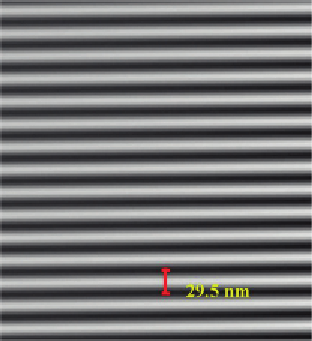Biomedical Engineering Reference
In-Depth Information
Figure 17.9
View of an enlarged portion of a fringe pattern extracted from the FT shown in
Figure 17.4
and
corresponding to the highest evanescent order.
To get a scale parameter for the FT plane, it is possible to use dimensionless variables and
a screen with a known aperture, e.g., a calibrated pinhole. The reduced coordinate system
can be used:
8
<
u
M
ξ
5
(17.26)
v
M
:
η
5
where
M
is the magnification of the image.
The reduced coordinate system connects the object space (in this case, the first principal
plane of the relay lens,
z
52
R
sph
,
Figure 17.3
) with the focal plane of the spherical lens
(
z
5
R
sph
1
f
,
Figure 17.3
).
The values of parameters involved in the definition of the scale are
n
s
5
1.36,
λ
5
0.6328
m. Between the object plane and the Fourier plane, there is
an inverse relationship; hence, the diffraction pattern of a known pinhole consisting of
circular fringes is connected to the diameter of the aperture through the dimensionless
variables such that by measuring the minima or maxima of the diffraction pattern it is
possible to determine the actual radius of the aperture. This procedure was utilized in the
present study to determine the scale to connect the diffraction fringes of the polystyrene
microsphere with the actual radius of the sphere. The product
n
s
μ
m, and
f
5
11.214
μ
λ
f
is equal to
m
2
.
C
5
1.36
3
0.6328
3
11.214
5
9.651
μ




Search WWH ::

Custom Search